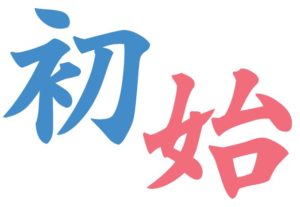 There are a number of words in Japanese that have the same pronunciation and roughly the same meaning but can be written with two or more different kanji.
There are a number of words in Japanese that have the same pronunciation and roughly the same meaning but can be written with two or more different kanji.
In some cases the two are interchangeable, but often they have a subtle difference in implication and sometimes a distinctly different (though related) meaning.
I am going to be covering some of these over the next little while. So let’s begin at the beginning!
Hajimeru means “begin”. But it can be written in two ways:
始める
and
初める
Does it matter which one we use?
In this case, there is a distinct difference between the two. They both mean “begin”, but they mean it in different senses. Let’s look at them.
 初 – Cloak ‘n’ Dagger at the Beginning of Time
初 – Cloak ‘n’ Dagger at the Beginning of Time
This one I call “cloak ‘n’ dagger” since it is made up of the kanji elements for clothes and sword.
It means begining in the time sense. The first time something is done or the beginning of something (in a time sense), for example:
初めは怖かった
hajime wa kowakatta
(it was) scary at first / (I was) scared at first (literally “the beginning was scary (to me)”
It is often used in the form hajimete, meaning “for the first time”. For example:
日本は初めてですか
nihon wa, hajimete desu ka?
Is this (your) first (visit to) Japan?
The construction actually makes more sense if we render it according to the system in Unlocking Japanese:
“Speaking of Japan, is this (your) first time (to visit)?”
Cloak ‘n’ Dagger sounds like an old show, doesn’t it? Useful to remember, because the on-reading of 初 is regularly sho, unlike 始, whose on-reading is regularly shi.
 始 – The Lady on the Pedestal, Starting to Act
始 – The Lady on the Pedestal, Starting to Act
始is made up of the elements 女 (female) and 台 (platform or pedestal).
This 始める refers to action rather than time. It doesn’t mean “the first time I did something” but “beginning to do something”, sometimes a subtle distinction, but quite definite. In
仕事を始めよう
Shigoto wo hajimeyou
Let’s start work
we are taking action. Work isn’t just “starting” at a particular time. We are actively starting to work.
Sometimes the two kanji can be used in similar circumstances, but 初 is always stressing the first time or beginning period of something. 始 is stressing taking action.
So when you see the lady mount the stage or pedestal, you know that she is always about to do something. And shi is also the regular on-reading for this kanji.
It doesn’t always have to be a person acting. It can be a thing. For example:
夜が明け始めた
yoru ga akehajimeta
Dawn began to break (literally: “night lighten-began”)
Note that ga. As explained in Unlocking Japanese, it always marks the actor, the subject. Literally, the sentence means “night began to clear”, and night, the actor, is doing something. It is becoming light/clear. Thus the pedestal lady is the correct kanji.
Hajimemashite
So does it matter which one we use for hajimemashite? In my early days I used to write this one in kana because I could never quite remember.
Hajimemashite, sometimes vaguely translated as “pleased to meet you”, actually means “this is the beginning (of our acquaintanceship)”, so the correct kanji is 初 (cloak ‘n’ dagger, the time-beginner).
Armed with this knowledge you will have a clearer idea of the meaning of words using these kanji as well as a nearly-always-correct idea how to pronounce them in two-kanji on-reading words.
始 is very consistently shi, but remember that 初, while mostly sho, is sometimes hatsu, as in 初恋 hatsukoi (first love). People with cloaks and daggers often have hats pulled down over their eyes too!
Very interesting. Good job.
On my N3 JLPT, this question came up on the kanji section, and I panicked…. I knew both kanjis meant “start/begin/first” but… in that specific situation, I didn’t know which one to use. It was at that time, I realized that there were different times to use each kanji! But I didn’t know when to use which! This has been very insightful. I haven’t totally mastered it yet… Could you give us some more examples, please?
Like… both 初め and 始め are read as “haji” right? What about when they are read as “sho” and “shi”? Is that like in… 最初? “saisho”? When is “shi” used?… 開始? “kaishi” (opening time).
I didn’t know how much i DIDNT KNOW, until I started diving deeper into kanji >.<
はじ is the kun-reading of both kanji but their on-readings are しょ and し respectively. So just as in the examples you give, on-readings will mostly appear in two-kanji combinations. Learn the secrets of on and kun readings and how to use them to your advantage here.